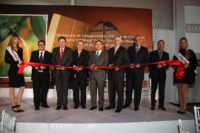Hershey hosts cocoa summit in Mexico
Company looks to restore cocoa farming in the region.

It was about 3,500 years ago, in 1500 B.C. somewhere in South Central Mexico that a culinary genius amongst the Olmecs first realized that cocoa should be used for food.

|
| Cocoa plants are planted in Mexico. Photo provided by Hershey. |
The Mesoamerica cultures of the Mayans and Aztecs — also in southern Mexico — thought it was so amazing that they considered it a “food of the gods.”
Sadly though, in the present day, Mexico, the very birthplace of cocoa recipes, is home to a beleaguered cocoa farming industry.
That’s where the Hershey Co. comes in. The chocolate maker is working to revitalize the cocoa farms in Mexico.
A little more than a year ago, the company announced “The Mexico Cocoa Project,” a 10-year, $2.8-million initiative to help the region.
And on July 13, The Hershey Co. and cocoa supplier Agroindustrias Unidas de Cacao SA de CV (AMCO) hosted a Cocoa Summit in in Tapachula, Chiapas. The goal was to bring together a wide range of stakeholders committed to saving Mexico’s cocoa industry.
“A summit with so many important stakeholders demonstrates the power of what happens when all interested parties come together around a common cause with a goal of benefiting farm families, communities and consumers who love chocolate,” says Tonathiu Acevedo, director of AMCO.
Specifically, The Mexico Cocoa Project aims to provide the following: Farm renovation training; good agricultural practices training; and hundreds of thousands of disease-tolerant cocoa trees. The new tree seedling will help restore more than 1,000 hectares of cocoa farmland in the Chiapas region of Southern Mexico, which have been devastated by tree disease.
The effort intends to quadruple yields, increase family incomes and contribute to the worldwide supply of sustainable cocoa.
Hershey's Mexico project to last 10 years
The Cocoa Summit is a key milestone for the decade-long project, which began in the summer of 2012.
Hershey and AMCO hosted cocoa farmers and their families from the Chiapas region of Mexico at a forum for sharing information about cocoa-growing best practices, success stories and testimonies, all of which create the foundations for successfully restoring sustainable cocoa farming in the region for the long term.
Since the project began more than a year ago, Hershey and AMCO have built and maintained nurseries to grow disease-resistant tree stock. The area has been hard hit by Moniliasis, also known as frosty pod rot, a disease that attacks the fruit of the cacao tree, causing its cocoa beans to become unusable. As a result, cocoa yields in the area have dropped by nearly half since 2005.
Following the summit, the partners will begin distributing the first 100,000 disease-resistant trees to cocoa farmers to begin the rehabilitation of the region’s cocoa plantations.
The inaugural cocoa summit will help raise awareness among Mexican farmers and across the country about the work underway to return the Mexico cocoa industry to a thriving business. The program partners also hope to grow interest among young adults who may want to work in the cocoa industry.
Participating farmers were trained in the highest standards of sustainable cocoa and labor practices, which will enable them to be certified by third-party cocoa certification NGOs. Farmers who receive cocoa trees and training through the program are free to sell their cocoa to whomever they choose.
“We have a strong and growing Hershey business here in Mexico serving local consumers for more than 40 years and our employees in Mexico are very proud to be part of an effort to improve the livelihoods of local cocoa farmers,” says de la Barreda. “We are also very proud about the fact that today we are already using Chiapas cocoa in our chocolate in Mexico and we look forward to the opportunity to increase the use of this delicious, high-quality Mexican cocoa in our products and complete full end-to-end sustainability to our Mexico chocolate manufacturing, from certified cocoa through chocolate produced under our high-quality, ethical manufacturing standards.”
Hershey working on global growth
Hershey’s growth in Mexico is part of the company’s strategic vision to grow its international business through key focus markets, including Mexico.
The Mexico Cocoa Project is one of The Hershey Co.’s numerous global cocoa sustainability programs and part of its “21st Century Cocoa Plan,” which reflects the company’s deep commitment to corporate social responsibility and the environment.
The plan addresses an ongoing concern of the cocoa industry, which is supporting the long-term sustainability of the world’s cocoa supply. Last year, Hershey committed to using 100 percent certified cocoa in its products globally by 2020. Hershey’s percentage of certified cocoa will surpass 10 percent of its total cocoa volume this year and increase to between 40 and 50 percent by 2016.
Looking for a reprint of this article?
From high-res PDFs to custom plaques, order your copy today!










